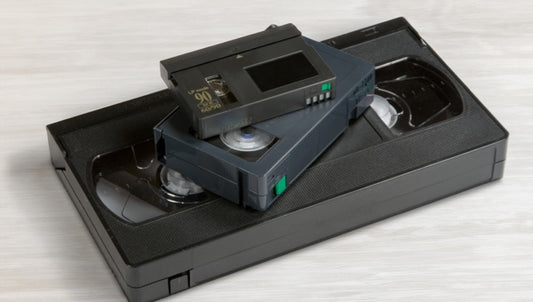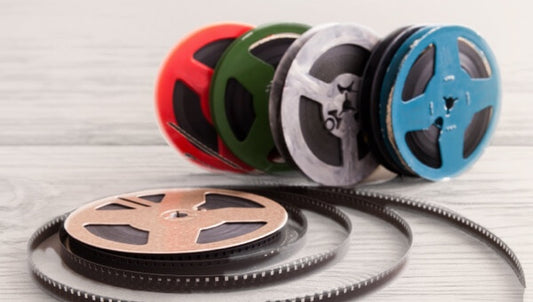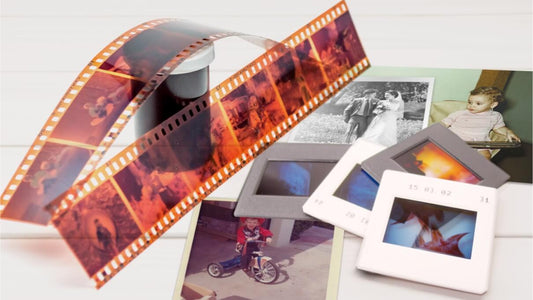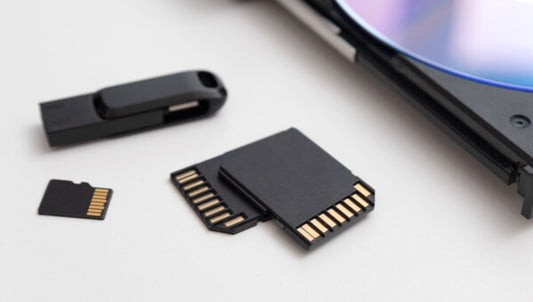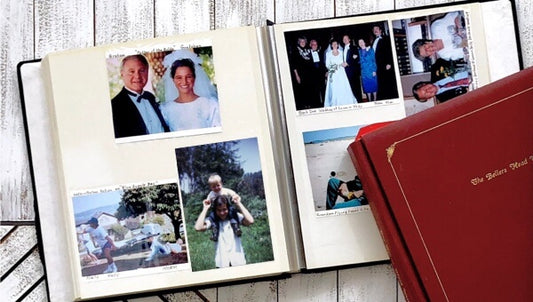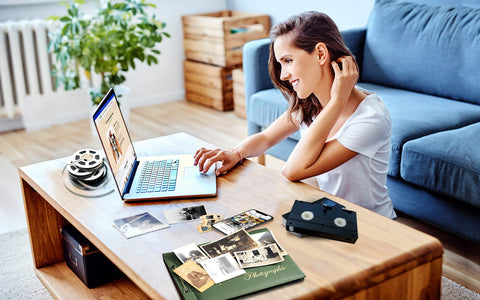Audio cassette tapes were the most popular way to listen to music on the go before the release of the CD. They could play music on a portable cassette player, in your car, or at home in a boombox, but how do cassette tapes work?
With over 20 years of preserving memories, Capture archival experts understand how important it is to also preserve analog formats and their history. We put together this guide to understand cassette technology and how it works.
Keep reading to learn about cassette tapes, how they record audio signals, the methods they use to playback the audio so that you can listen, and even how to care for your cassette tapes and preserve them forever.
Jump to:
- Overview of Cassette Tape Technology
- Recording on Cassette Tapes
- Playback Mechanism
- Sound Quality and Noise Reduction
- Maintenance and Care
- Comparison with Other Audio Technologies
Overview of Cassette Tape Technology

Cassette tapes were first developed by the Philips company in 1962 for analog audio storage. They used magnetic tape technology that would also be used when the 8-track tape came out a couple of years later and even in VHS and Betamax tapes. For cassettes, though, the magnetic tape storage was only used for audio.
The cassette used two miniature spools that held the magnetically coated polyester-type plastic film. The entire cassette tape is made of this film around spools and rollers encased in a plastic cartridge. Additionally, a felt pad would act as a playback head for the compact reel-to-reel tape.
These basic components used the ferric oxide magnetic layers to store sound waves carved temporarily into the tape, but there were other cassette tape formats. Before the compact cassette that was popular in 80s cars, many companies came up with their own take on the cassette format.
For example, in 1971 the Advent Corporation introduced the Model 201 tape deck that combined Dolby Type B noise reduction and chromium oxide tapes to start the era of Hi-Fi audio cassette tapes. This led to portable cassette players and tape recorders like the Sony Walkman.
There were also metal tapes, blank tapes, and various types of tape players available from the late 70s through the 80s, and into the 90s and beyond. While this information provides a background on the cassette tape mechanism, we need to dig a little deeper to answer the question, “How do cassette tapes work?”
Recording on Cassette Tapes

To record audio onto a blank cassette tape, the audio signals must be converted into magnetic particles and patterns. This can be done with a cassette recorder, which often also acts as a cassette player. The magnetic tape has a plastic coating with a thin layer of iron oxide particles that act as a magnetic powder.
The recording head of a tape deck uses a C-shaped magnet to convert the incoming sound wave using a microphone. When the sound waves are converted into an electric signal, the tape moves past the recording head that magnetizes the iron oxide powder to carry the electronic signal converted from sound waves.
Then, when you playback the tape, the tape head reproduces the electronic signals and re-converts them into audible sound waves through the loudspeaker or amplifier. Basically, the sound waves are etched as a code in the magnetic layer similar to how sound is etched as grooves into a vinyl record.
Additionally, there is an erase head in a tape recorder machine that erases the signals on the magnetic field during playback. This allows you to record and re-record on the cassette as many times as you want, similar to what you could do with old VHS tapes.
The result was countless DIY mixtapes given as gifts for grandpa, dad, and mom as well as girlfriends and boyfriends with the most romantic tunes you could find on the radio. You could even decorate your mixtape gifts with the most popular 80s colors and styles.
Playback Mechanism

As we mentioned, the cassette tape playback mechanism reproduces the electronic signals of the recording on cassette tapes to record sound. Then, it plays them as sound waves through a speaker. This requires the use of a playback head instead of the recording head that’s used to record the audio in the first place.
Additionally, the capstan, or the rotating spindle that moves the recording tape through the mechanism, has to run at the right time through the rubber wheels, called pinch rollers. At the right speed, the sound waves will be played as originally intended, but if it’s too fast or too slow they will be distorted.
This technology is also used for rewinding and fast-forwarding cassette tapes. When you pause, play, stop, rewind, and fast-forward cassette tapes, the capstan and pinch rollers stop moving the magnetic tape or move it faster in one direction or the other.
This was not possible on other audio formats like vinyl records or 8-tracks and is one of the reasons why cassette decks became the standard for vehicle audio. Additionally, there were other great benefits of cassettes like noise reduction that made them one of the most popular icons of the 1980s.
Sound Quality and Noise Reduction
While the sound quality of cassette tapes was good enough for most people, especially in their vehicles or while using a portable tape player, there were certainly issues with playback quality. Not only is there a subtle hissing sound when playing a cassette, but the depth of audio quality is also quite shallow when compared to digital recordings or even vinyl records.
For example, while cassettes have a dynamic range somewhere between 50 and 75 dB, CDs have a significantly better dynamic range of 96 dB. Finally, noise intrusion is much more noticeable, which negatively impacts sound quality. Due to these issues, noise reduction technology was introduced.
Dolby noise reduction on cassette tapes was introduced in 1968 to eliminate the hissing sound. This noise reduction option used dynamic pre-emphasis during recording as well as dynamic de-emphasis during playback. This improves the signal-to-noise so that the hiss wouldn’t be noticeable if you recorded onto blank tapes at a high-end recording level.
Despite these cassette tape components, analog formats including audio cassettes and VHS tapes only last so long. That’s why it’s so important to maintain them and care for them properly.
Maintenance and Care
If you have old cassette tapes, then it’s important that you use best practices for storing them, handling them, and playing them. This will ensure they last as long as possible, but the truth is that they won’t last forever no matter what. That’s why it’s so important to not only convert audio cassettes to digital, but to convert all analog formats to digital using one of the best digitization services or on your own.
Still, you should store your cassettes similar to how you would store old film, photos, or family heirlooms. Keep them in a cool, dark, dry place. Humidity can damage the magnetic field while heat can warp the cassette tape head and other components.
Another tip for cassette tape maintenance is to avoid dust, debris, or even fingerprints from getting on the cassettes. If that happens, make sure you clean them thoroughly by slowly and carefully running the magnetic tape through the spools and cleaning off the exposed portion. For even better cleaning, you can take the cartridge off and clean the interior of the cassette.
Also, if you play the tapes too often, you can reduce cassette tape durability. Because of this, it’s best to either convert tapes to digital or to create a duplicate cassette tape for regular use. That way you can keep the original in great condition.
Finally, if it becomes damaged then you can use a similar process that you would for VHS tape repair. That is, you can splice a broken magnetic tape, replace the case, ensure the reel is tight enough, and untangle the magnetic tape. You can even get cassette repair kits on Amazon and other online stores.
Comparison with Other Audio Technologies

There are some advantages of cassette tapes compared with other audio technologies, even Mp3 players and CD players. For one thing, it was much easier to record tunes or talk shows from the radio onto a cassette tape. All you needed was a tape recorder boombox with AM/FM radio capabilities.
This wasn’t possible with CDs or Mp3s and to add music to an iPod or CD, you must have the right software, CD burner, or downloaded audio files. However, that wasn’t enough to save the audio cassette from being replaced by CDs.
That’s because CDs not only offered higher audio quality, more durability, and easy track skipping, but were also becoming more and more affordable. Plus, while there are differences between CD vs DVD, a data CD could store image and video files and even video games, whereas a cassette could only store audio.
Compared with vinyl records, audio cassettes may not have had the same sound quality, but they also didn’t skip. That made them the clear choice for car stereos and portable players, similar to the 8-track. However, audiophiles love the sound of vinyl records, which has kept them somewhat popular even after most people began to turn from VHS to DVD, cassette to CD and Mp3, and analog camcorder to digital.
That being said, there has been a recent resurgence in cassette tape sales. This is probably partially due to nostalgia, but even modern artists like Taylor Swift and Harry Styles. This has contributed to a 28% increase in cassette tape sales from 2021 to 2022.
Maybe it’s all nostalgia, but it could also be due to the fact that people like collecting physical items. Whatever the reason, the resurgence of retro cassette tapes doesn’t seem to be slowing down anytime soon.
Conclusion
Cassette tape player operation may seem simple as you press play, rewind, or record, but most people don’t really know the answer to, “How do cassette tapes work?” Now you can impress your friends with knowledge of magnetic particles that are converted from sound waves and reintroduced as music at normal playback speed on cassette tapes.
However, as we mentioned before, the magnetic particles on audio cassettes as well as videotapes like Betamax and VHS will not hold their charge forever. That’s why you should choose Capture to digitize all your most precious family memories and home movies. Click here to learn about our video digitization services!





